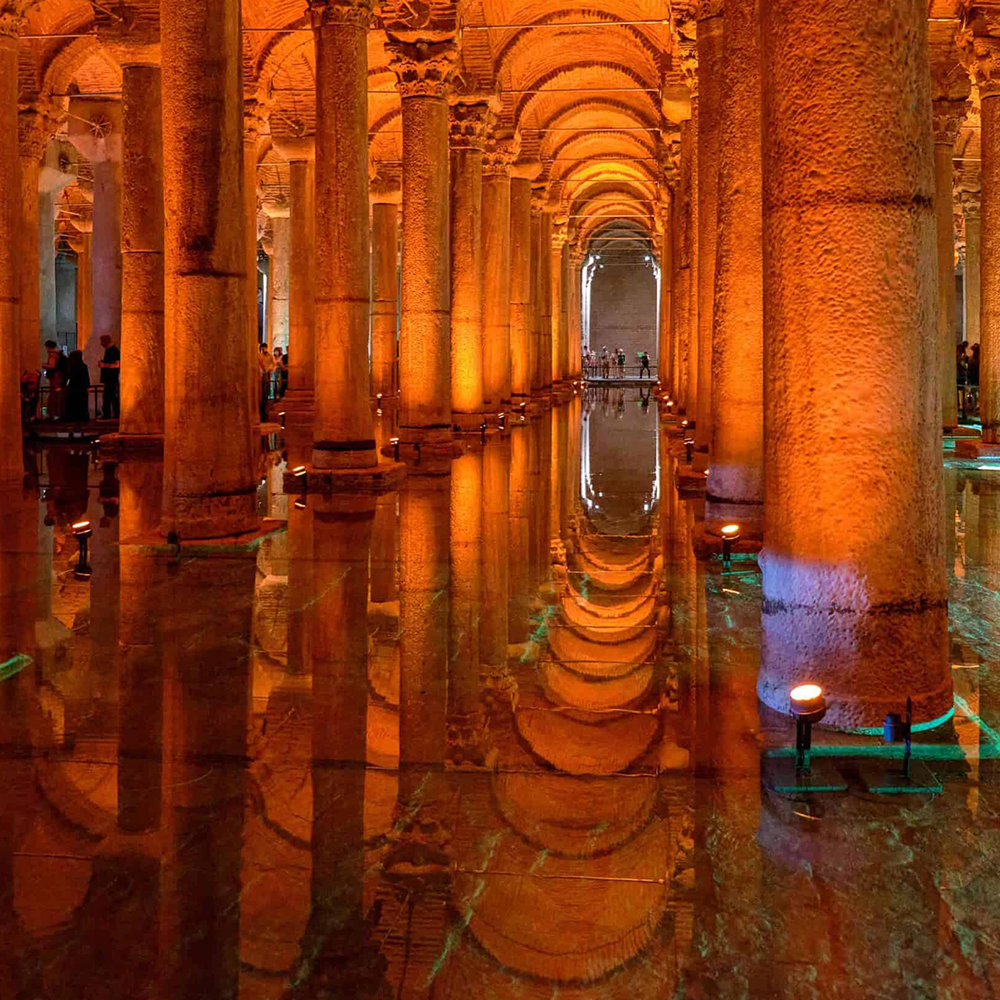History
The Basilica Cistern Museum is one of the most significant cultural landmarks where we can trace the rich history of Istanbul. Built by the Eastern Roman Emperor Justinian I (527–565), this grand underground reservoir is known as the “Basilica Cistern” (Cisterna Basilica in Latin) due to its location beneath the former Stoa Basilica. Because of its seemingly endless rows of marble columns rising from the water, it has been popularly referred to as the “Subterranean Palace” (Yerebatan Sarayı).
With a water storage capacity of 80,000 tons, the Basilica Cistern is the largest enclosed cistern in the city. Covering an area of approximately 10,000 square meters, the massive rectangular structure is 140 meters long and 70 meters wide.
Historical records indicate that the cistern supplied water from aqueducts and rainfall to the Great Palace and surrounding buildings for centuries. It was also connected to the Hadrian Aqueduct, one of the city’s key water channels.
Inside the cistern, there are 336 columns, each 9 meters high, arranged in 12 rows with 28 columns in each. The columns, carved from various types of marble, are mostly monolithic, with some consisting of two sections. While some columns feature ornate Corinthian-style capitals, others have plain designs. Most columns are cylindrical, with a few exhibiting fluted or angular shapes.
The cistern’s 4.8-meter-thick brick walls and floor were coated with a thick layer of waterproof mortar made from a special lime-based mixture known as Horasan mortar, ensuring the structure remained watertight.
Following the Ottoman conquest of Constantinople in 1453, the Basilica Cistern continued to supply water for Topkapı Palace for a time. However, as residential buildings increased in the area, locals also began using it.
For centuries, Western travelers were unaware of the cistern’s existence until it was “rediscovered” in the mid-16th century. Between 1544 and 1555, French naturalist and topographer Petrus Gyllius documented the structure, measuring its dimensions and recording its 336 columns. He also noted the presence of wells above the cistern, which allowed light and air to enter, and observed locals drawing water, rowing boats inside, and even catching fish.
During the Ottoman period, the Basilica Cistern underwent restorations under Sultan Ahmed III by architect Mehmet Ağa of Kayseri and again during the reign of Sultan Abdul Hamid II. More substantial restoration efforts took place between 1955 and 1960, when nine structurally compromised columns were reinforced with thick concrete layers.
In the major renovation carried out by the Istanbul Metropolitan Municipality (İBB) between 1985 and 1987, two Medusa head sculptures were discovered, placed as column bases. One Medusa head is positioned upside down, while the other is laid sideways. These remarkable examples of Roman sculpture have captivated visitors and inspired various legends.
One legend describes Medusa as one of the three Gorgons from Greek mythology, a female monster whose gaze could turn people to stone. Another story suggests that Medusa was a beautiful woman with dark eyes and long hair, loved by Perseus, the son of Zeus. However, Athena, also in love with Perseus, became jealous and turned Medusa’s hair into snakes. From then on, anyone who met her gaze would be petrified. Perseus later used Medusa’s severed head as a weapon to defeat his enemies.
Following the restoration, the Basilica Cistern Museum was opened to visitors in 1987. Over the years, it has hosted numerous national and international events, welcoming prominent figures such as former U.S. President Bill Clinton, Dutch Prime Minister Wim Kok, former Italian Foreign Minister Lamberto Dini, former Swedish Prime Minister Göran Persson, and former Austrian Chancellor Thomas Klestil.
After an extensive restoration project undertaken by İBB Heritage, the Basilica Cistern Museum reopened on July 22, 2022. Now strengthened against potential earthquakes and redesigned with a modern museum concept, it continues to offer a unique experience to visitors. The museum, managed by Kültür AŞ, also hosts temporary exhibitions, contemporary art shows, cultural events, and concerts, creating a space where history and art converge.
THE BASILICA CISTERN MUSEUM IS READY FOR THE FUTURE
The Basilica Cistern Museum has undergone the most extensive restoration in its history under the protection of the Istanbul Metropolitan Municipality (İBB). The restoration, carried out by İBB Heritage teams following the principles of “archaeological restoration,” has reinforced the city’s largest underground reservoir against potential earthquakes while implementing a modern museum experience.
Due to the structural risks posed by a potential earthquake in Istanbul, the cistern was strengthened using a newly designed tension system made of stainless steel and fine-section modern materials. This reinforcement, which can be removed if needed, ensures the cistern’s stability for the future.
As part of the restoration, the existing 2-meter-high concrete walkway, which placed excessive weight on the structure, was replaced with a lightweight modular steel platform in harmony with the site’s historical identity. Additionally, 700 truckloads of concrete were meticulously removed to relieve structural stress. The new walkway brings visitors closer to the cistern’s monumental columns, enhancing their appreciation of the space’s vast height and depth.
Another key intervention was the removal of cement-based flooring layers, which had risen up to 50 cm above the original surface. For the first time, visitors can now walk on the 1,500-year-old original brick flooring. A total of 1,440 cubic meters of cement-based mortar, which had damaged the cistern’s historic fabric, was carefully removed.
A dynamic lighting system was also implemented to preserve the mystical atmosphere of the site while allowing for cultural and artistic events. The entrance and exit areas were redesigned to meet modern needs, and a museum shop was added. With these improvements, the Basilica Cistern Museum stands ready to share its historical, architectural, and cultural legacy with future generations.



